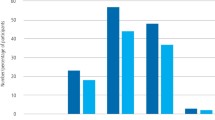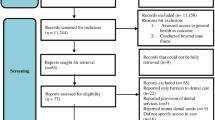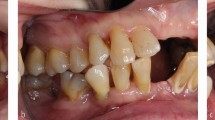Key Points
-
The model described in this article is becoming recognised and widely used in salaried dental services in UK as a useful methodology for describing the complexity of special care patients.
-
NHS commissioners are interested in using the model to assist in commissioning these services.
-
The model has potential for use in research in special care dentistry.
Abstract
Routine dental care provided in special care dentistry is complicated by patient specific factors which increase the time taken and costs of treatment. The BDA have developed and conducted a field trial of a case mix tool to measure this complexity. For each episode of care the case mix tool assesses the following on a four point scale: 'ability to communicate', 'ability to cooperate', 'medical status', 'oral risk factors', 'access to oral care' and 'legal and ethical barriers to care'. The tool is reported to be easy to use and captures sufficient detail to discriminate between types of service and special care dentistry provided. It offers potential as a simple to use and clinically relevant source of performance management and commissioning data. This paper describes the model, demonstrates how it is currently being used, and considers future developments in its use.
Similar content being viewed by others
Log in or create a free account to read this content
Gain free access to this article, as well as selected content from this journal and more on nature.com
or
References
Fiske J, Dougall A . Access to special care dentistry, part 1. Access. Br Dent J 2008; 204: 605–616.
Lewis K. Does my contract value look big in this? Dentistry 2007 April 5. pp 3
British Society for Disability and Oral Health. Commissioning tool for Special Care Dentistry. 2006.
Department of Health. Valuing people's oral health: a good practice guide for improving the oral health of disabled children and adults. 21 November 2007.
Hally J, Freeman R . A field trial conducted in the Salaried Dental Services NHS Highland. Personal communication.
Author information
Authors and Affiliations
Corresponding author
Additional information
Refereed paper
Rights and permissions
About this article
Cite this article
Bateman, P., Arnold, C., Brown, R. et al. BDA special care case mix model. Br Dent J 208, 291–296 (2010). https://doi.org/10.1038/sj.bdj.2010.294
Accepted:
Published:
Issue date:
DOI: https://doi.org/10.1038/sj.bdj.2010.294
This article is cited by
-
Comparing the BDA case mix tool and simplified case mix tool for stratification of public dental patients with disabilities in South Australia
British Dental Journal (2023)
-
The use of the BDA Case Mix Model to assess the need for referral of patients to specialist dental services
British Dental Journal (2016)
-
What proportion of dental care in care homes could be met by direct access to dental therapists or dental hygienists?
BDJ Team (2016)
-
What proportion of dental care in care homes could be met by direct access to dental therapists or dental hygienists?
British Dental Journal (2015)
-
Assessing sedation need and managing referred dentally anxious patients: is there a role for the Index of Sedation Need?
British Dental Journal (2015)



